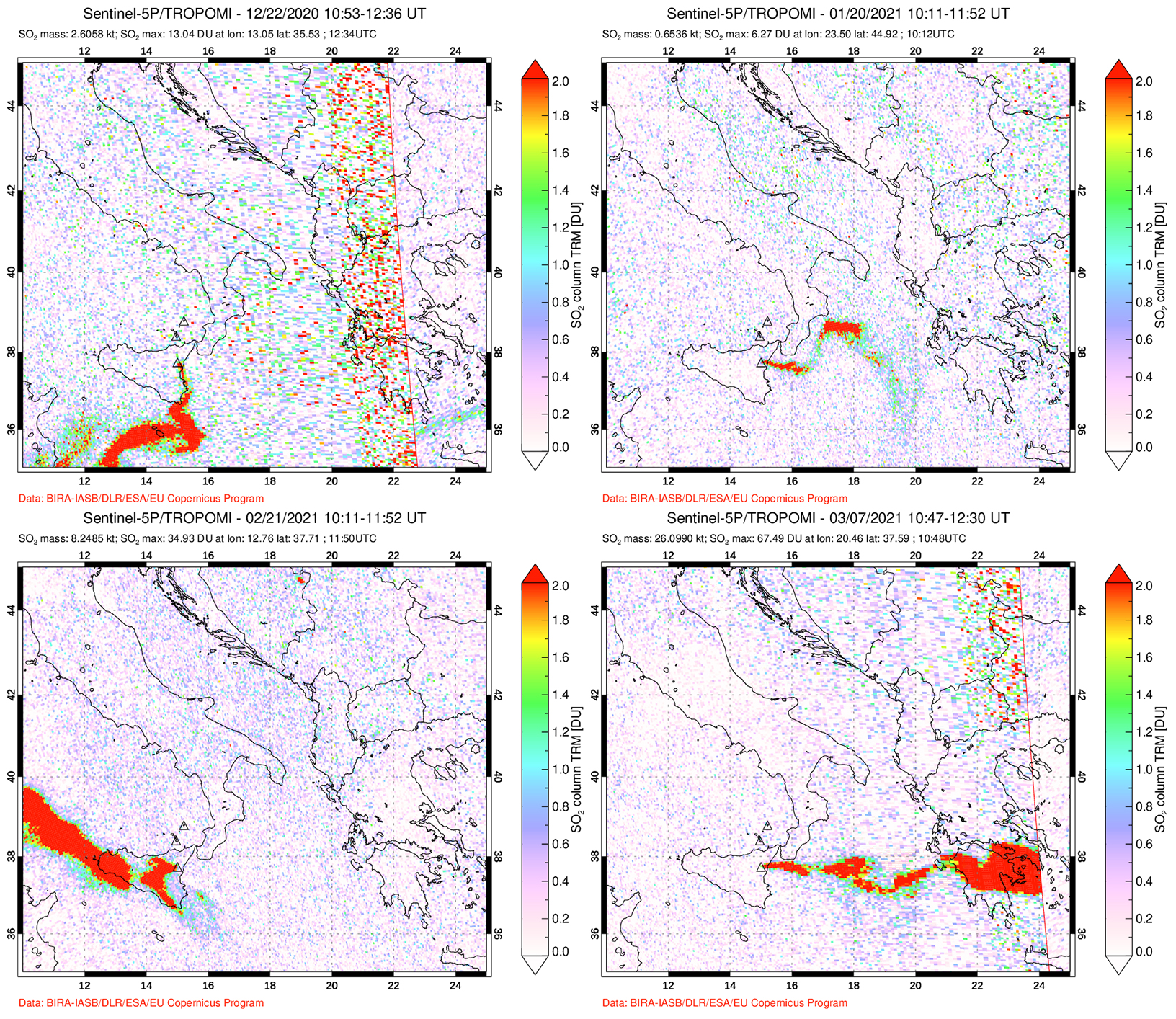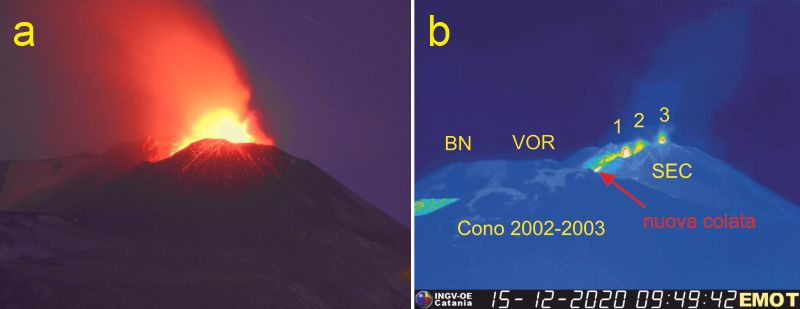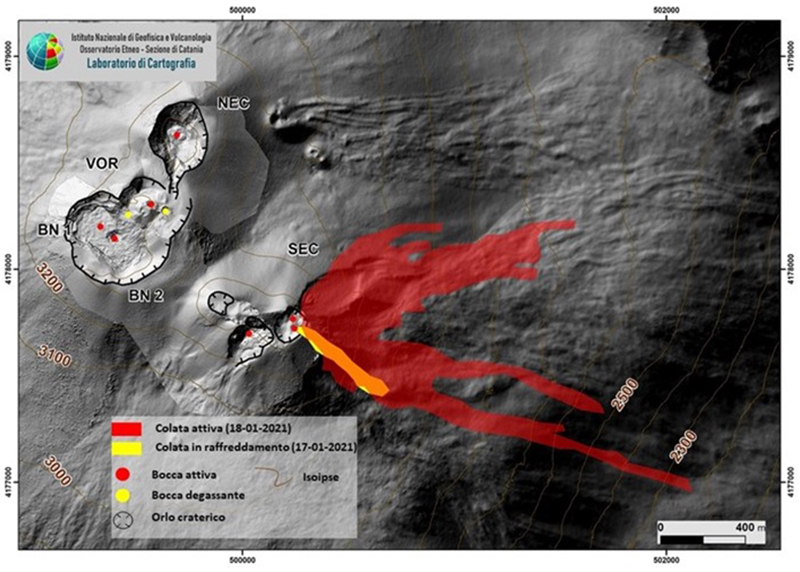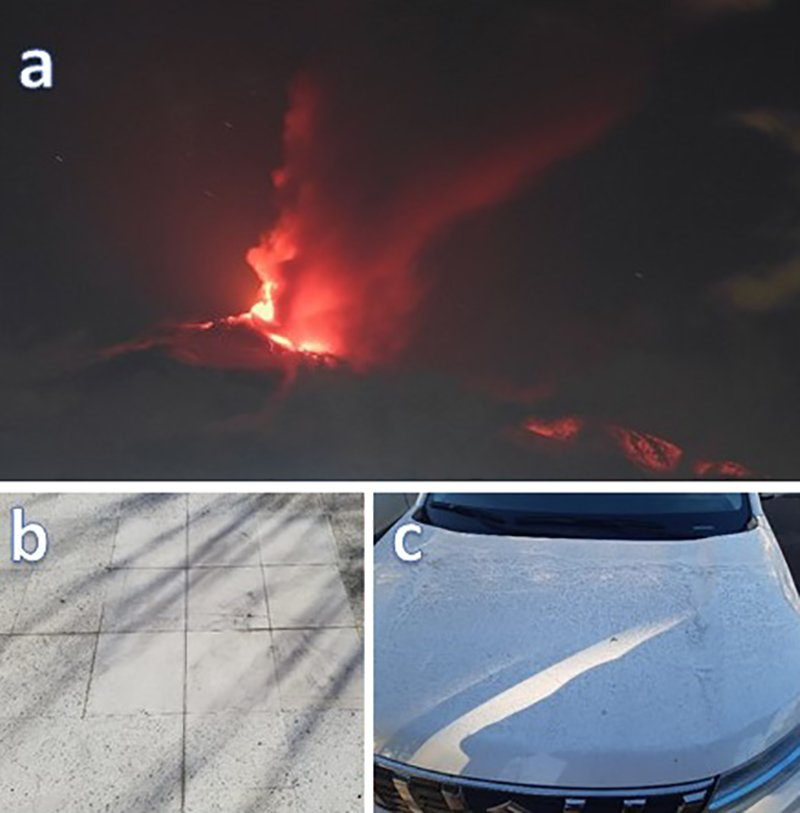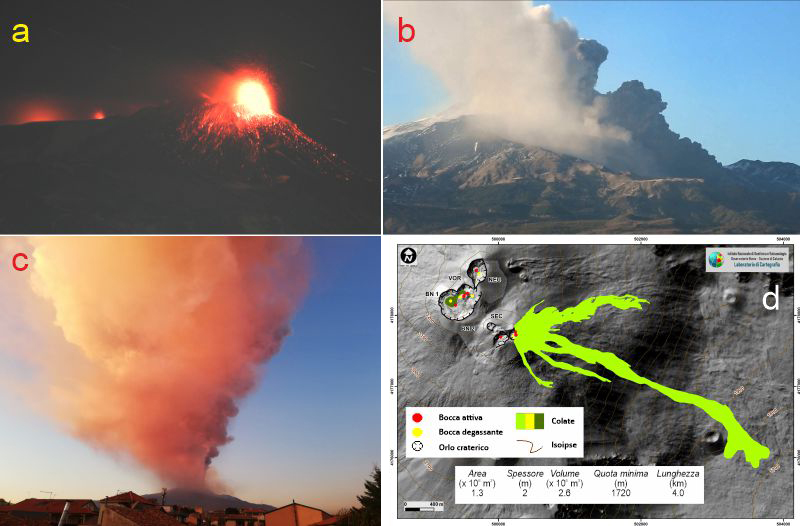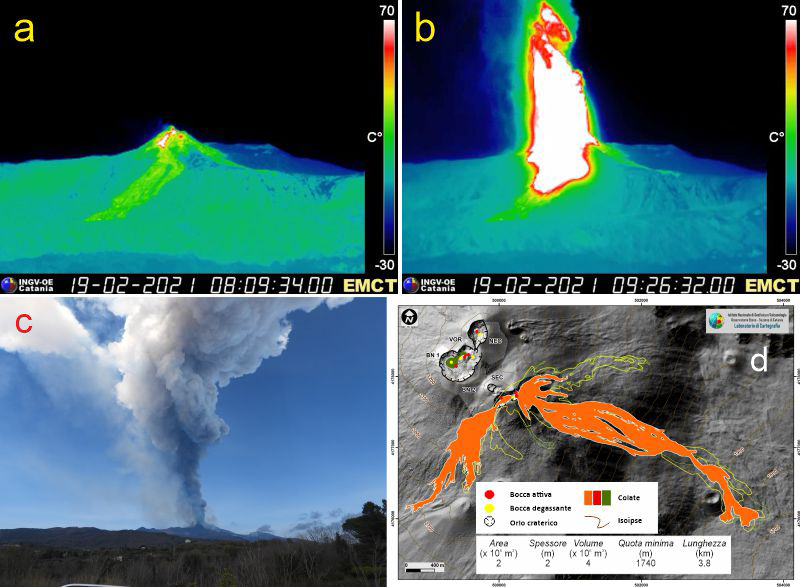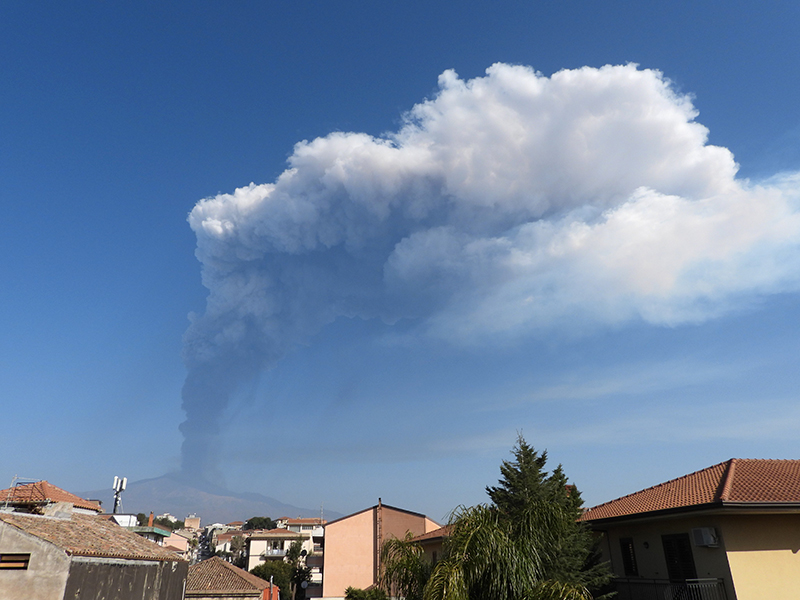Report on Etna (Italy) — April 2021
Bulletin of the Global Volcanism Network, vol. 46, no. 4 (April 2021)
Managing Editor: Edward Venzke.
Edited by Kadie L. Bennis.
Etna (Italy) Frequent explosions, ash plumes, fountaining, and lava flows during December 2020-March 2021
Please cite this report as:
Global Volcanism Program, 2021. Report on Etna (Italy) (Bennis, K.L., and Venzke, E., eds.). Bulletin of the Global Volcanism Network, 46:4. Smithsonian Institution. https://doi.org/10.5479/si.GVP.BGVN202104-211060
Etna
Italy
37.748°N, 14.999°E; summit elev. 3357 m
All times are local (unless otherwise noted)
Etna is located on the island of Sicily, Italy, and has had eruptions that date back 3,500 years. Its most recent eruptive period began in September 2013 and more recently has been characterized by frequent Strombolian explosions, effusive activity, and ash emissions. Activity has commonly originated from the summit areas, including the Northeast Crater (NEC), the Voragine-Bocca Nuova (or Central) complex (VOR-BN), the Southeast Crater (SEC, formed in 1978), and the New Southeast Crater (NSEC, formed in 2011). Another crater, referred to as the "cono della sella" (saddle cone), developed during early 2017 in the area between SEC and NSEC. This report covers activity from December 2020 through March 2021, consisting of frequent Strombolian explosions of variable intensity, effusive activity, ash emissions, and ashfall. Information for this report comes from weekly and special reports by the Osservatorio Etneo (OE), part of the Catania Branch of Italy's Istituo Nazionale di Geofisica e Vulcanologica (INGV).
Summary of activity during December 2020-March 2021. Intra-crater Strombolian explosions that varied in frequency and intensity throughout the reporting period, and the accompanying ash plumes that rose to a maximum altitude of 11 km, primarily originated from the Southeast Crater (SEC), Voragine Crater (VOR), and occasionally the Northeast Crater (NEC) and Bocca Nuova Crater (BN). Beginning in mid-February a series of short lava fountaining events occurred in the SEC that continued through March. These episodes were also characterized by accompanying ash plumes, incandescent ejecta, and lava flows.
MIROVA (Middle InfraRed Observation of Volcanic Activity) analysis of MODIS satellite data shows strong and frequent thermal anomalies throughout the reporting period (figure 319). Some of these anomalies were markedly high in mid-December, mid-January, and mid-March. According to the MODVOLC thermal algorithm, a total of 190 alerts were detected in the summit craters during December through March; thermal anomalies were reported for nine days in December, eleven days in January, fifteen days in February, and sixteen days in March. Frequent Strombolian activity contributed to distinct SO2 plumes that drifted in multiple directions (figure 320).
Activity during December 2020. During December, INGV reported intra-crater Strombolian explosions in the SEC, NEC, and BN. During the more intense SEC explosions material was ejected onto the flanks. Gas-and-steam emissions were reported in the VOR. A field survey on 13-14 December showed that the SEC was an irregular ellipse 150 x 230 m open to the SW. On 13 December Strombolian activity intensified at 2020 and around 2300 evolved to lava fountains which lasted through 2350, though explosions continued. Collapses of the SW part of the SEC at 2315 resulted in pyroclastic flows that traveled up to 2 km, covering the Monte Frumento Supino cone (SSW flank). Around that time two fissures opened on the SW flank of the SEC and produced lava flows until about 2350 (figure 321). A third minor pyroclastic flow went down the SSW flank at 2330. Two lava fountains were seen during 0050-0110 on 14 December.
During a field inspection on 14 December scientists noted that the two lava flows on the S and SW flanks were cooling; the S flow had widened near the base of the SEC and formed four main lobes, one of which had stopped just NW of the cones that formed in 2002-2003 (figure 322). The SW flow traveled SSW, branched, curved around the W part of Monte Frumento Supino, and then stopped. An explosion in the easternmost SEC vent generated an ash plume at 1352 that rose to 4 km altitude and drifted S. Additionally, on 14 December sporadic ash explosions resumed in the VOR; incandescent ejecta was visible at night. On 15 December a new lava flow formed on the SW flank of the SEC at 0924 that advanced a few hundred meters. Eruptive activity briefly stopped in the E vent of the SEC during the afternoon of the 15th and during 16-18 December exhibited strong degassing and nighttime incandescence.
Seismic tremor amplitude gradually increased on 20 December, though weather conditions prevented observations. On 21 December at 1008 Strombolian activity increased in the SEC from the central and easternmost vents. Activity evolved to lava fountaining that lasted an hour, as well as an ash plume that rose to 10 km altitude and drifted NE. An active lava flow was still visible on the SW part of the cone which had collapsed on 13 December. A second flow was observed at 1521 on the S slope of the SEC that descended toward the Valle del Bove. Activity continued through the night (figure 323), and on 22 December at 0350 Strombolian activity increased in the central and easternmost vents; around 0415 a lava flow from the SW flank traveled W, overlapping cooling lava from 21 December. Lava fountaining began again at 0519 and fed three lava flows: one from the S flank traveled SW for 2.8 km and was 600 m wide, branching off to the W and E of Monte Frumento Supino, a second that traveled 2.8 km E toward the Valle del Bove, and a third that originated at the E vent of the SEC that traveled 1.3 km ENE toward the Valle del Leone (figure 324). At 0520 a few small phreatic explosions in the Valle del Bove were due to the lava flow interacting with snow. By 0600 the lava fountains gradually subsided and stopped, though Strombolian explosions persisted at varying intensities. On 24 December at 0830 explosive activity in the E vent of the SEC gradually increased, ejecting material above the crater rim and emitting ash that drifted E.
On 29 December at 0750 there was a gradual increase in explosive activity in the E vent of the SEC, producing ash emissions that drifted ENE. Around 0900 Strombolian activity further intensified, ejecting coarse material onto the E flank of SEC (figure 325), but by 1000 the explosions had decreased. Intra-crater Strombolian activity in the NEC, VOR, and BN continued with sporadic ash emissions through the rest of the month; explosions in the VOR intensified, ejecting material above the crater rim.
Activity during January 2021. Activity in January continued with intra-crater Strombolian explosions of variable intensity in the SEC, NEC, VOR, and BN with sporadic ash emissions. On 4 and 6 January at least two episodes of intense Strombolian explosions produced continuous ash plumes that drifted E and ejected coarse pyroclastic material. A lava flow on 17 January breached the SEC at 0740 and traveled to the base of the cone toward the Valle del Bove (figure 326); the lava effusion rate increased at 0819, and the flow reached an elevation of 3 km by 1000. Volcanic tremor amplitude and Strombolian activity intensified at 2000 on 18 January, evolving into lava fountains through 2130. A lava flow emerged in the E vent of the SEC at 2015 and moved 2 km ESE toward the Valle del Bove. Lava fountaining produced a plume that drifted SE, resulting in ashfall in Fleri and Acicastello (figure 327). During 2130-2147 a second lava flow on the N side of the SEC reached a length of 1.3 km. By 19 January the explosions decreased in intensity and the lava flows had begun to cool. On 20 January a new lava flow on the N side of the SEC traveled ENE at 0140, overlapping the previous flow on the 18th; by 1830 it was no longer active. The VOR was characterized by almost continuous Strombolian explosions that ejected material above the crater rim. Satellite imagery from 27 January showed that a small lava flow from a vent in the N section of the VOR was pouring into the BN. The BN also produced Strombolian explosions that often ejected material above the crater rim. At night, summit crater incandescence was observed in the NEC.
Activity during February 2021. Variable Strombolian activity continued into February at all four summit craters; the last time this occurred was during 1998-1999. The most intense, almost continuous, Strombolian explosions at the SEC originated from two vents in the eastern top of the cone; less intense activity occurred at the S vent. Intra-crater Strombolian activity at the NEC sometimes produced nighttime incandescence. Explosions at the BN sometimes ejected coarse material above the crater rim. A field inspection on 5 February showed that three scoria cones had been built around vents at the bottom of the crater. Another nearby cone occasionally produced dense emissions. Intra-crater lava flows continued to spill into the BN from the VOR, overlapping those formed in late January. On 6 February around 0530 Strombolian activity intensified in the E vent of the SEC and produced an ash plume that drifted E.
During the morning of 15 February explosive activity at the SEC intensified, with activity continuing at the E vents. Sporadic and sometimes violent explosions were also observed at the saddle cone; intra-crater explosive activity continued in the BN, VOR, and NEC. On 16 February at 1700 lava began advancing down the E flank of the SEC for a few kilometers. A partial cone collapse at 1705 produced a pyroclastic flow that traveled 1.5 km along the W wall of the Valle del Bove. The activity changed to lava fountains around 1710, rising 500-600 m high and generating an ash plume that rose to 6-10 km altitude and drifted S (figure 328). Centimeter-sized lapilli and ash was observed in Nicolosi (16 km S), Mascalucia (19 km S), and as far as Catania (29 km SSE) while fine ashfall was reported in Syracuse (60-80 km SSE). Lava flows continued to advance into the Valle del Bove, reaching an elevation of 2 km by 1759. Another lava flow from the SEC traveled N toward the Valle del Leone; smaller lava flows traveled N and S, reaching 2.9 km elevation. Explosive activity decreased and lava fountaining stopped between 1800 and 1838, though ashfall continued; by 2025 the lava flows had stopped. Strombolian activity persisted at the SEC overnight during 16-17 February and stopped by 0715 on 17 February, though sporadic explosions were reported in the VOR at 0420, 0435, 0444.
An eruptive event began at 2330 on 17 February, about 30 hours after the previous one, with a lava flow from the E vents in the SEC, followed by lava fountaining at 0100 on the 18th that rose 600-700 m (figure 329). The lava flow advanced toward the Valle del Bove, the NE, SE, and SW through the saddle vent (“bocca della sella”), covering an area of about 1 km. A second flow on the N flank of the SEC moving toward the Valle del Leone was about 1 km long. Another flow was reported on the S side of the SEC. The resulting ash plume drifted SE, causing ashfall in Zafferana, Etna, and Acireale. The lava fountains ended between 0140-0155 on 18 February, though the lava flows continued to advance.
During the morning of 19 February a lava flow effused from the E vents in the SEC at 0855, followed by a rapid increase in explosions and renewed lava fountaining (figure 330). A line of 4-5 vents produced “fan-shaped” lava fountains at 0953. An ash plume rose to 10 km altitude and drifted SE, causing ashfall in some towns. The lava flow that descended toward the Valle del Bove interacted with snow, causing strong explosions, and were accompanied by rockfalls on the flanks of the SEC. By 1110 the explosive activity had stopped.
Weak Strombolian activity was visible in the late afternoon of 20 February (figure 331). At 2230 a small lava flow from the E vent in the SEC descended 150-200 m into the Valle del Bove. By 2300 the activity had changed to pulsating lava fountains. Beginning at 0100 on 21 February more western vents became active and the E vents ejected lava 600-800 m high. At 0128 lava fountains were ejecting lava up to 1 km high and were sustained for about 10 minutes (figure 331). At the same time, a lava flow from the saddle vent moved a few hundred meters SW. An ash plume rose to 10 km altitude, resulting in ashfall on the SW flank. At 0200 the lava fountains decreased in intensity and by 0220 explosive activity stopped. Periodic ash emissions rose from both the S and E vents later in the evening. A lava flow in the SEC advanced 1 km toward the Valle del Bove. Lava fountains and Strombolian explosions continued at multiple vents. Activity intensified again during 0218-0220 on the 22nd, with lava fountains over 1 km high sending incandescent material onto the flanks. Lava flows in the Valle del Bove reached 3.5-4 km from the crater. During 0430-0515 about 20 strong explosions from SEC vents ejected incandescent bombs that landed at the base of the cone. The NEC was characterized by strong degassing and crater incandescence, often accompanied by Strombolian activity.
During the evening on 22 February weak Strombolian explosions were visible in the SEC. The frequency and intensity of the explosions increased and by 2210 material was ejected onto the flanks. Jets of lava were ejected 300 m high at 2305, and by 2327 lava fountains were reported from a second SEC vent. Lava overflowed the crater at 2328 toward the Valle del Bove. Within the first hour of 23 February lava fountains rose more than 1.5 km and an ash plume reached 10 km altitude, causing ashfall to the NW. Lava overflowed the S vent and descended SW. At 0115 the lava fountains decreased. Strombolian activity intensified again at 0450, accompanied by ash emissions. Two lava flows traveled SW and SE, the latter of which reached 1.7-1.8 km elevation. By 1000 the lava flows were no longer active; the flow on the SW flank had traveled a few hundred meters, overlapping the previous flows.
The lava fountaining episodes continued; Strombolian activity at the two vents in the SEC increased during the late afternoon on 24 February that evolved into lava fountains reaching 400 m above the crater. Ash emissions also persisted in the SEC. Lava overflows from the crater headed ESE toward the Valle del Bove as far as 2-4 km and in the S area of the SEC. During 1900-2122 the lava fountains reached 500 m high and a resulting ash plume rose as high as 11 km altitude. A second lava flow traveled SW and at 2100 a pyroclastic flow descended 1 km into the Valle del Bove. The lava fountains in the SEC stopped by 2335, though the lava flow remained active in the SW and E sections.
Weak Strombolian activity on 28 February was visible at 0810 that evolved to lava fountains at 0839, feeding lava flows that traveled E toward the Valle del Bove. The fountains abruptly intensified at 0902 with jets of lava rising 700 m above the crater rim. An ash plume rose as high as 11 km altitude and drifted ESE, resulting in ashfall to the E (figure 332). A small lava flow at the S part of the SEC began at 0909, followed by a pyroclastic flow at 0920. The lava fountains ended abruptly at 0933, though the lava descending E remained active. By 1526 the lava flow in the Valle del Bove was no longer active.
Activity during March 2021. Weak Strombolian activity resumed on 2 March at 1145 in the SEC, which increased in intensity at 1234 with ash emissions. From 1324 to 1550 lava fountains generated an ash plume 9 km above the crater, depositing ash and lapilli in Nicolosi, Aci San Antonio (18 km SE), Pedara (15 km SSE), and Catania (29 km SSE). On 4 March Strombolian explosions increased at 0200 and produced ash emissions that dispersed NE (figure 333). At the same time, Strombolian activity from VOR ejected material above the crater. Degassing persisted in the NEC. Around 0320 the Strombolian explosions in the SEC evolved to lava fountains and at 0515 a lava flow from the E section of the base of the cone was traveling toward the Valle del Bove. Strombolian activity in VOR changed to lava fountains at 0859 that were 300 m high. An ash plume rose 11 km above the crater, depositing ash and lapilli in Fiumefreddo (19 km ENE), Linguaglossa (17 km ESE), and the area of Reggio Calabria. Lava fountains continued.
Another eruptive episode on 7 March starting between 0100 and 0200 included Strombolian explosions and minor lava effusions at the E base of the SEC that descended into the Valle del Bove. At 0430 an increase in Strombolian activity generated an ash plume that rose to 5 km altitude and drifted E. The lava reached an elevation of 2.8 km altitude by 0450. Strombolian activity intensified again at 0520 and the lava flow advanced to 2.7 km elevation. Lava fountains at 0720 generated another ash plume that rose to 10 km altitude and drifted E. INGV-OE personnel reported ash and lapilli deposits in Milo (11 km ESE), Fornazzo (10 km ESE), Trepunti (17 km ESE), Giarre (17 km ESE), Macchia di Giarre (16 km ESE), Mascali (18 km E), Riposto (19 km ESE), and Torre Archirafi (20 km ESE). Strombolian activity resumed at 1050 and was over by 1500.
Similar Strombolian activity in the SEC on 10 March changed to lava fountaining and a large eruption plume that rose to at least 9 km altitude and drifted ENE (figure 334). Ash and lapilli were reported in Mascali, Giarre, and Fiumefreddo. A lava flow from the S vent reached an elevation of 1.8 km. By 0430 on 10 March the lava fountaining had stopped, though sporadic ash emissions continued until 0700. On 12 March Strombolian activity in the SEC and accompanying ash emissions began again. As the activity intensified, lava overflowed the E part of the SEC, descending toward the Valle del Bove. Lava fountaining was observed up to 500 m and generating an ash plume that rose to 6 km altitude and drifted E. Within an hour, lava had advanced from an elevation of 2.8 km to 2 km. By 0939 the ash plume had risen to 9-10 km altitude and resulted in ashfall in Fleri, Milo, Fornazzo , Giarre, Santa Venerina (15 km SE), and Torre Archirafi (20 km ESE) (figure 335). Lava fountaining had stopped at 1050, though weak Strombolian activity and ash emissions persisted until 1115. The lava flow advanced as far as 1.7 km elevation while a second lava flow expanded on the W slope of the Valle del Bove for an average length of 3 km and a volume of roughly 1 million cubic meters. Strombolian activity continued in the NEC, BN, and VOR, producing minor ash emissions.
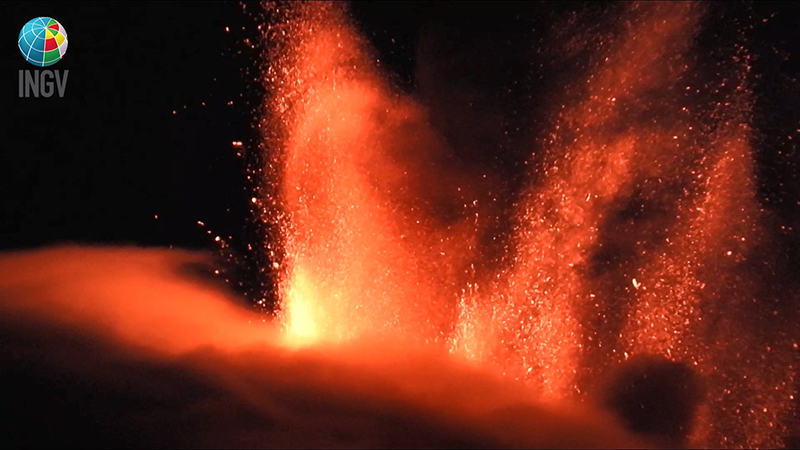 |
Figure 334. Photo of the nighttime lava fountaining activity at Etna during 9-10 March 2021. Courtesy of INGV Youtube channel. |
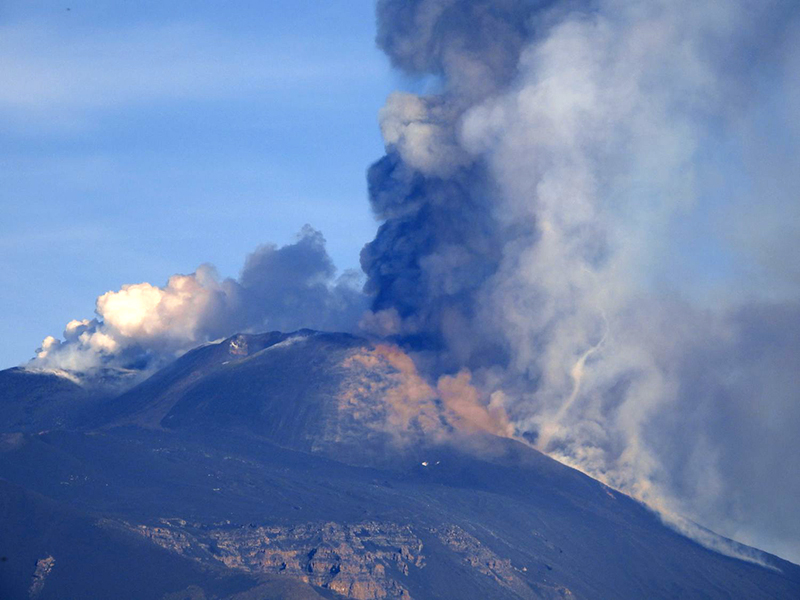 |
Figure 335. Photo of an ash plume rising above Etna’s Southeast Crater on the morning of 12 March 2021. Taken from Tremestieri Etneo. Photo by Boris Behncke, INGV. |
On 14 March Strombolian activity began at 2110 that evolved into lava fountaining at 0048 on the 15th (figure 336). Lava traveled toward the Valle del Bove as an ash plume drifted E (figure 337). By 0343 lava fountaining had stopped, though weak Strombolian activity and lava flows continued. On 17 March at 0155 weak Strombolian activity was observed, changing into lava fountaining at 0319. An ash plume drifted SE and a lava flow was moving toward the Valle del Bove, the latter of which overlapped the one from 15 March. Due to cloud cover, observations were limited and discontinuous. Fountaining activity stopped at 0717 and was followed by explosive activity. Weather conditions cleared the summit on 18 March at 2142, showing explosions in the SEC and a lava flow in the Valle del Bove. On 19 March at 0734 explosive activity was visible in the SEC, which intensified at 0915, accompanied by ash emissions. Lava fountaining started at 0935 with an accompanying ash plume that drifted ENE. By 1136 lava fountaining had stopped and changed to Strombolian activity, which gradually decreased. Only sporadic explosions were visible with minor ash emissions by 1350; lava flows along the Valle del Bove were reported in the late morning.
 |
Figure 336. Photo of a lava fountain episode at Etna’s Southeast Crater during the night of 14-15 March 2021. Taken from Tremestieri Etneo. Photo by Boris Behncke, INGV. |
Though weather conditions often prevented a clear view of the summit, weak Strombolian activity was reported in the SEC at 2005 on 23 March, which had evolved into lava fountaining at 0330 on 24 March (figure 338). At 0335 a lava flow from the SEC was seen branching toward the Valle del Bove and the SE. A pyroclastic flow followed the lava at 0336, descending into the Valle del Bove. The lava fountains generated an ash plume that rose to 6-7 km altitude and drifted SSE, resulting in ashfall on the S slope and in Catania. Lava fountaining gradually decreased at 0700 and by 0945, it had stopped; the lava flows continued to advance. Intra-crater Strombolian activity continued in the NEC, BN, and VOR, accompanied by sporadic weak ash emissions. After the fountains stopped, another ash plume was seen rising to 4.5 km altitude and drifting SE. At night, ashfall was reported in Milia and Trecastagni (16 km SE). The explosions had stopped by 1347. By 25 March the two active lava flows had stopped.
On 30 March weak Strombolian activity in the SEC resumed around 0607 with a single ash explosion that quickly dispersed near the summit (figure 339). Over the course of the day activity at the SEC gradually changed from degassing to continuous weak Strombolian activity at about 1830 from at least two active vents. This activity increased during the night, throwing lava above the crater rim accompanied by sporadic ash emissions. Several lava flows effused from the S base vent. The main part of the flow traveled toward the Valle del Bove with other smaller flows descending to the S and SW. Two other vents at the S base had opened by the evening, one of which ejected spatter a few tens of meters high. Throughout the night, periods of lava fountaining were detected while the main lava flow descended the W wall of the Valle del Bove. Strombolian activity intensified at 1850 and produced an ash plume that rose to 4 km altitude and drifted SSW. At 0000 there was a gradual transition from Strombolian activity to lava fountaining.
 |
Figure 339. Photo of an ash plume rising from Etna’s Southeast Crater on the morning of 30 March 2021. Photo by Boris Behncke, INGV. |
Geological Summary. Mount Etna, towering above Catania on the island of Sicily, has one of the world's longest documented records of volcanism, dating back to 1500 BCE. Historical lava flows of basaltic composition cover much of the surface of this massive volcano, whose edifice is the highest and most voluminous in Italy. The Mongibello stratovolcano, truncated by several small calderas, was constructed during the late Pleistocene and Holocene over an older shield volcano. The most prominent morphological feature of Etna is the Valle del Bove, a 5 x 10 km caldera open to the east. Two styles of eruptive activity typically occur, sometimes simultaneously. Persistent explosive eruptions, sometimes with minor lava emissions, take place from one or more summit craters. Flank vents, typically with higher effusion rates, are less frequently active and originate from fissures that open progressively downward from near the summit (usually accompanied by Strombolian eruptions at the upper end). Cinder cones are commonly constructed over the vents of lower-flank lava flows. Lava flows extend to the foot of the volcano on all sides and have reached the sea over a broad area on the SE flank.
Information Contacts: Sezione di Catania - Osservatorio Etneo, Istituto Nazionale di Geofisica e Vulcanologia (INGV), Sezione di Catania, Piazza Roma 2, 95123 Catania, Italy (URL: http://www.ct.ingv.it/it/ ); Boris Behncke, Istituto Nazionale di Geofisica e Vulcanologia (INGV), Sezione di Catania, Piazza Roma 2, 95123 Catania, Italy; MIROVA (Middle InfraRed Observation of Volcanic Activity), a collaborative project between the Universities of Turin and Florence (Italy) supported by the Centre for Volcanic Risk of the Italian Civil Protection Department (URL: http://www.mirovaweb.it/); Hawai'i Institute of Geophysics and Planetology (HIGP) - MODVOLC Thermal Alerts System, School of Ocean and Earth Science and Technology (SOEST), Univ. of Hawai'i, 2525 Correa Road, Honolulu, HI 96822, USA (URL: http://modis.higp.hawaii.edu/); NASA Global Sulfur Dioxide Monitoring Page, Atmospheric Chemistry and Dynamics Laboratory, NASA Goddard Space Flight Center (NASA/GSFC), 8800 Greenbelt Road, Goddard, Maryland, USA (URL: https://so2.gsfc.nasa.gov/).



